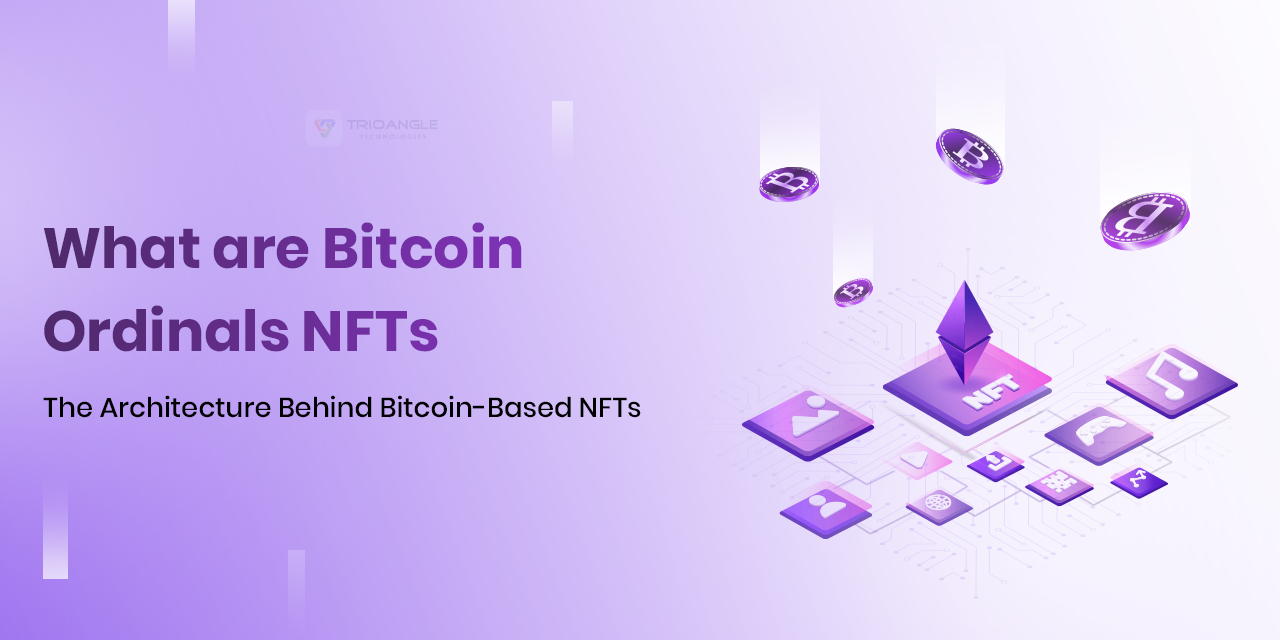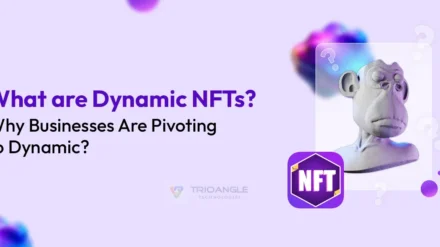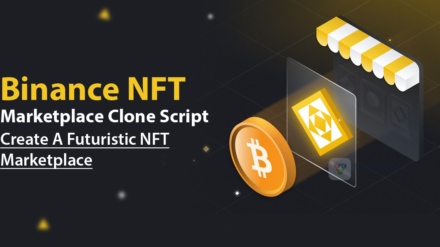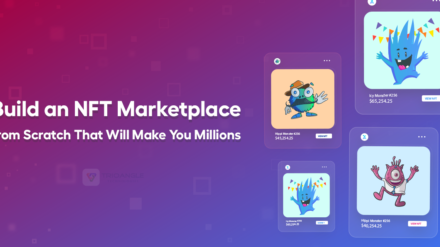What if NFTs could live forever on the most trusted blockchain? This is What are Bitcoin Ordinals? bring to the table. As an entrepreneur navigating the fast-evolving Web3 world… you’ve likely heard of Ethereum-based NFTs. But now, a new shift is happening on the Bitcoin layer itself.
So, what are Bitcoin Ordinals??? And why are they catching the attention of builders, creators, and investors alike? Satoshi inscription NFTs aren’t just collectibles. They represent a new era of permanence, security, and minimalism on the Bitcoin blockchain NFTs layer. Whether you’re building a brand, a platform, or a community… Understanding this innovation is key to staying ahead.
In this blog, we’ll break down how Ordinals Bitcoin works, their underlying architecture… the minting process, and how they unlock new opportunities for Bitcoin NFT marketplace development. If you’re ready to explore the next frontier of Bitcoin blockchain NFTs, you’re in the right place. Let’s dive in.
What Are Bitcoin Ordinals?
With the groundbreaking invention of Bitcoin Ordinals. Individual satoshis- the smallest units of Bitcoin. Now it can contain unique data, such as text, photos, or videos.
On the Bitcoin blockchain, this process is known as inscription. It converts basic Bitcoin into NFTs, or collectible digital assets. Unlike Ethereum-based NFTs, Bitcoin NFTs ordinals don’t rely on smart contracts.
Instead, they embed metadata directly into Bitcoin’s witness data. Preserving the core blockchain’s security.
This method, known as the Ordinals protocol Bitcoin. Enables a new class of Satoshi inscription NFTs. without altering Bitcoin’s consensus rules. As a result, Bitcoin blockchain NFTs remain immutable and decentralized.
For NFT entrepreneurs, this opens doors to launch trustless… and secure Bitcoin NFT marketplace development initiatives. You can now mint, store, and trade NFTs natively on Bitcoin without bridges or external layers.
Want to learn how wrapped Bitcoin ordinals differ. or how NFT storage on Bitcoin actually works? Stick around!!! This is just the start of the Bitcoin NFT revolution.
What are Bitcoin Ordinals NFT: The Architecture Behind Bitcoin-Based NFTs
To understand the power of Bitcoin Ordinals… Entrepreneurs must look into the core architecture. That makes it possible to mint NFTs directly on the Bitcoin blockchain.
Unlike Ethereum or Solana, where NFTs rely on smart contracts. Bitcoin NFTs ordinals are built using a unique protocol without changing Bitcoin’s base code.
Let’s break down how it all works from a technical and architectural standpoint.
#1 The Foundation: Ordinals Protocol on Bitcoin
- The Ordinals protocol Bitcoin indexes every satoshi (the smallest unit of BTC). By assigning a unique number based on its mining order.
- This indexing is termed as Satoshi inscription NFTs.
- A satoshi can carry NFT-like data, such as images or text. By embedding it within Bitcoin’s transaction structure.
- This data is stored in the witness part of the transaction (introduced in SegWit). It makes it possible without altering Bitcoin’s consensus layer.
#2 Inscriptions: The Core of Bitcoin NFT Architecture
- The inscription creates an actual NFT. Where digital content is written onto a specific satoshi.
- Think of it as etching metadata directly onto the coin. This makes the NFT fully on-chain, preserving immutability.
- Unlike wrapped Bitcoin ordinals. Which need third-party assets or bridges. These inscriptions remain native to the Bitcoin blockchain NFTs ecosystem.
#3 Key Components of the Architecture
- UTXO Model: Bitcoin’s Unspent Transaction Output model. It plays a crucial role in tracking NFT ownership. Each inscribed satoshi is a distinct UTXO, traceable and transferable.
- Witness Data: Introduced by SegWit. This area of the transaction allows NFT data storage without bloating the main block.
- Taproot Upgrade: Enables more flexible script structures. It enhances privacy and scalability for Bitcoin NFT minting processes.
4. Metadata and Standards
There is no universal Bitcoin NFT standard like ERC-721. But, creators follow community-defined formats to structure Bitcoin NFT metadata during inscription. Tools like OrdinalHub and Gamma offer helpful Ordinals inscription guides for new builders.
5. Real Use Cases and Marketplace Potential
From digital art to gaming assets, Bitcoin NFT use cases are growing. Entrepreneurs exploring Bitcoin NFT marketplace development now have a decentralized, trustless architecture to build on.
In short, what are Bitcoin ordinals? They’re a gateway to NFT creation on Bitcoin. Powered by clever use of satoshis, witness data, and layered upgrades.
This architecture is lean, secure, and ideal for the next generation of on-chain NFT innovation.
How Bitcoin Ordinals Work?
Consider Bitcoin Ordinals as the process of giving each satoshi a serial number. And then adding digital data to it to understand how they work. Each satoshi gets indexed using the Ordinals protocol Bitcoin.
This indexing is key. It allows you to track and inscribe data on specific units of Bitcoin.
Let’s break the process down into simple steps for NFT entrepreneurs:
#Step 1: Numbering Satoshis
Each satoshi in Bitcoin is given a unique number using the Ordinals protocol. This creates a way to track and identify individual satoshis across the network.
#Step 2: Inscriptions Begin
Using a special process known as inscription. Creators attach data such as text, art, or video to a chosen satoshi. This data, often referred to as Bitcoin NFT metadata. This is added directly into Bitcoin’s witness data (a part of the SegWit upgrade). No changes are made to the Bitcoin consensus.
This is the key to Bitcoin NFTs architecture: the NFT lives on-chain and is immutable.
#Step 3: Minting the NFT
Once the inscription is complete, the satoshi becomes a Satoshi inscription NFT. This completes the Bitcoin NFT minting process. The inscribed satoshi is now a native NFT on Bitcoin. No bridge or token wrapping is needed. Unless you’re dealing with wrapped Bitcoin ordinals for use in other ecosystems.
Step 4: Transferring the NFT
These NFTs can now be sent, bought, or sold like any Bitcoin transaction. This creates direct NFT storage on Bitcoin. Permanent, decentralized, and secure.
Entrepreneurs can now tap into the Bitcoin blockchain NFT. for unique digital products or launch full-scale Bitcoin NFT marketplace development platforms. Understanding what are Bitcoin ordinals?? Gives you a front-row seat to the next big leap in NFT innovation.
Ready to Build on Bitcoin? Explore how Ordinals can power your next-gen NFT marketplace!
Step-By-Step Bitcoin NFT Minting Process Using Bitcoin Ordinals
Minting NFTs on Bitcoin is different from Ethereum or Solana. Here, NFTs are inscribed directly onto satoshis using the Ordinals protocol Bitcoin. Making them native to the chain. Below are the exact steps to create your own Satoshi inscription NFTs:
Step 1: Choose a Taproot-Compatible Wallet
Start by downloading a Bitcoin wallet that supports Taproot and Ordinals. Examples include Hiro Wallet, Xverse, or Unisat Wallet. These allow you to view and hold Bitcoin NFTs ordinals safely.
You’ll use this wallet to receive the inscribed NFT.
Step 2: Prepare Your Digital File for Inscription
Choose the content you want to inscribe. Image, text, audio, or video. Keep the file small (under 400 KB is ideal) because it will be stored fully on-chain.
This file becomes your NFT. It’s important to finish it before the inscription since changes are not possible later.
Step 3: Select an Ordinals Minting Platform
Use platforms like Gamma.io, OrdinalsBot, or Unisat Marketplace. These tools help you mint without needing to run your own full node.
They follow the latest Bitcoin NFT standards and simplify the Ordinals inscription guide.
Step 4: Upload the File and Set Metadata
On the platform, upload your file. Optionally, add metadata such as title, description, or format.
The data gets linked to a specific satoshi, forming your Bitcoin blockchain NFT.
Step 5: Confirm, Pay Fees, and Inscribe
Review your details. Pay the inscription fee (usually in BTC). The platform processes your request. And writes the data to the satoshi using SegWit witness space.
This is where your NFT is permanently embedded on-chain.
Step 6: Receive NFT in Your Wallet
Once the transaction is confirmed, the inscribed satoshi. (your NFT) will appear in your wallet.
You now own a native Bitcoin ordinal NFT. Fully decentralized, immutable, and secure.
Step 7: Store or List Your NFT
You can hold it, trade it, or list it on a Bitcoin NFT marketplace. Since these NFTs are stored on-chain, there’s no need for IPFS or centralized storage.
This step opens new opportunities in Bitcoin NFT marketplace development and real business use.
This step-by-step Bitcoin NFT minting process shows what are Bitcoin ordinals offer… a trustless way to build digital ownership. There’s no wrapping, no third-party token, just pure, on-chain innovation. Understanding how Bitcoin ordinals work is your key. To launch meaningful NFT ventures in 2025 and beyond.
Benefits of Bitcoin Ordinals Over Traditional NFTs
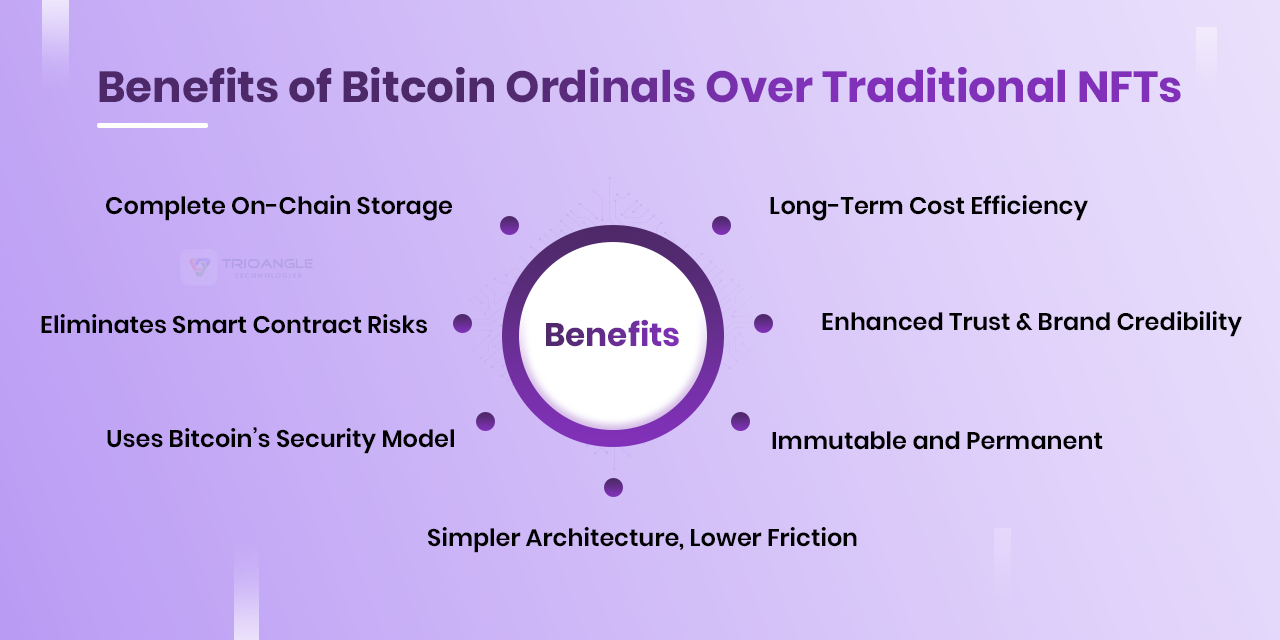
#1 Complete On-Chain Storage:
Traditional NFTs often store only metadata or image links on-chain. leaving assets vulnerable to external failures. With Satoshi inscription NFTs, all content image, code, or media. This is fully stored on the Bitcoin blockchain NFTs. No dependencies. No broken links. Total permanence.
#2 Eliminates Smart Contract Risks
Platforms like Ethereum rely on smart contracts that can be exploited or misconfigured. Bitcoin ordinals skip this risk entirely. The Ordinals protocol Bitcoin works without smart contracts. Offering a minimal, hardened security structure that’s native to Bitcoin’s core.
#3 Uses Bitcoin’s Security Model
By building NFTs on Bitcoin the most secure and battle-tested blockchain. entrepreneurs gain unmatched security. Ordinals Bitcoin inherit the resilience and integrity of Bitcoin’s network. Ensuring longevity and protection from censorship.
#4 Simpler Architecture, Lower Friction
No need to learn ERC standards or deal with token mechanics. Bitcoin NFTs architecture is direct: inscribe data on a satoshi. And that satoshi becomes a unique asset. This lowers the learning curve and reduces operational complexity for startups and developers.
#5 Immutable and Permanent
Traditional NFTs can be modified, burned, or removed. Bitcoin ordinals explained show that once inscribed, the NFT is forever. The data is immutable and locked into the chain itself.
#6 Enhanced Trust & Brand Credibility
Launching NFTs on Bitcoin taps into the network’s global trust and legacy. Businesses using wrapped Bitcoin ordinals or planning Bitcoin NFT marketplace development. Can attract crypto-savvy users seeking asset permanence and platform credibility.
#7 Long-Term Cost Efficiency
With no need for complex smart contracts or decentralized storage layers. The long-term maintenance and storage costs for Bitcoin NFT use cases drop. This appeals to startups aiming to minimize overhead and maximize reliability.
Alright, let’s wrap this up for Today!!!
Bitcoin Ordinals are rewriting the rules of NFTs permanently and transparently. By embedding data directly onto satoshis. They offer a cleaner, more secure way to create digital assets on the Bitcoin blockchain. For entrepreneurs exploring Bitcoin NFT marketplace development… this is more than innovation; it’s a massive opportunity to lead the next frontier.
Still asking, “What are Bitcoin Ordinals?” Now you understand they go beyond hype. These Bitcoin NFTs Ordinals bring true ownership and freedom from smart contract vulnerabilities.
Want to build your marketplace or integrate Satoshi inscription NFTs into your business? Trioangle can help you make it real. As pioneers in blockchain tech, they deliver custom solutions that are fast, secure, and future-ready.
Stick around!!! Our next blogs will decode more powerful use cases, tools, and tips to help you thrive in the Bitcoin NFT era. The revolution has just begun.

